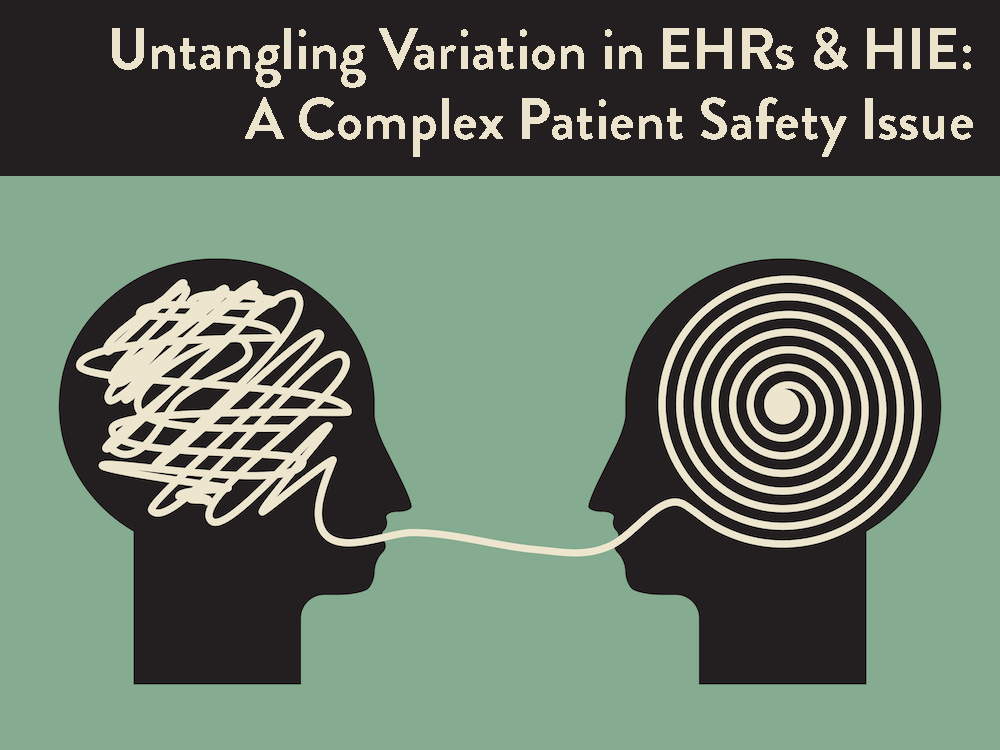UNTANGLING VARIATION IN EHRs & HIE: A COMPLEX PATIENT SAFETY ISSUE

by Gwen O’Keefe, MD, FACP | Principal, GO Healthcare Strategy
Imagine you’ve just spent a harrowing 4 days in the hospital with sudden onset of heart problems, had many tests, and are sent home with multiple appointments and new medications. The conversations with hospital staff passed in a blur. You don’t understand what the results of some of the tests showed, but you are confident that at your appointment with your primary care doctor, Dr. Sue Caring, all will be explained.
Now, imagine you are Dr. Caring, about to see one of your favorite patients. You are dismayed that he has developed a severe cardiac condition and know he will have many questions. You prepare for the visit by reviewing the discharge summary from the hospital but are frustrated with the amount of data presented in the 15 screens of that particular hospital’s discharge summary. It looks very different than the one from a different hospital you read earlier in the day. It’s nearly impossible to quickly comb through the overwhelming amount of data to find the key 5 pieces of information you need to really make sense of what happened. You have a nagging sense of unease that you may be missing a key follow-up item and could end up dropping the ball and harming your patient.
THE PROBLEM: HOW DID IT GET THIS WAY?
Nationally, most hospitals and physician practices have adopted Electronic Health Records (EHR). At the same time, national health information standards continue to mature and a variety of options exist to facilitate electronic health information exchange (HIE).
This ready access to standardized electronic clinical information offers great promise to enhance care coordination, improve patient safety, and simplify both administrative and clinical workflows. However, to date, this promise has not been realized to the degree it should.
While there are a variety of factors responsible for this diminished return on investment, one key issue relates to variability across EHR vendors and clinical organizations in how clinical information standards are being implemented. Of particular concern are the diverse approaches taken to implement the national standard for clinical information exchange, the Consolidated Clinical Document Architecture (C-CDA). The C-CDA was designed as the vehicle to extract, summarize, and transmit clinical information from a certified EHR.
Regional clinical and informatics leaders have recognized that the wealth of variations in C-CDA exchange across EHR vendors and clinical organizations makes coordination more difficult, limits the ability of clinicians to deliver optimal care to their patients, complicates workflow, and adds frustration to already overburdened care givers. Unfortunately, this even occurs within systems where they are using the same EMR!
THE SOLUTION: WHAT’S BEING DONE ABOUT IT?
A group of leaders in a workgroup I am honored to be facilitating has determined that it is a patient safety and clinical imperative to tackle this problem and improve the use of electronically exchanged information both within and across clinical systems. In recognition of this shared need, we have come together in a collaborative effort to improve the usefulness of the C-CDA discharge transaction in this region by creating best practices for electronic information exchange that optimize use of the information, by clinicians, to improve the health of individual patients and communities in Washington State and the Pacific Northwest.
The group has been meeting since May 2018 and has made substantial progress toward creating a best practice driven by clinical needs. This work is being supported by OneHealthPort who, on behalf of the group, has engaged a national firm to provide additional technical support in matching technical standards to clinical needs. OneHealthPort’s support will enable the group to make these clinical and technical best practices available to all clinical organizations in the state and lower the barrier to adopting a common framework for information exchange.
This is a unique collaborative effort to focus on discharge summary exchange across health systems in the US. So far, similar efforts going on anywhere else in the country have not been found. Our workgroup believes that this may be because we are fortunate to have clinical leaders onboard who understand that we can use the technical capabilities to make things better, and that a solution may not be possible without this type of clinical engagement and groundwork. Technology, we believe, is only a piece of the work needed to improve safety.
“We are making excellent progress and hope to have the clinical best practice completed by early 2019 and the technical implementation guide completed soon after,” says Jeff Clarke, MD, CMIO at Confluence Health in Wenatchee. “Then we look forward to working with our own organizations and others throughout Washington to implement later in 2019. If we are successful, by 2020 we should have substantially improved the transition pathway for patients across the state, and decreased clinician burden and frustration as well. Our guiding principle is the creation of a clinically relevant standardized document for optimal transition of care.”
Stay tuned for more details in 2019!
ABOUT THE AUTHOR
 Dr. Gwen O’Keefe is a clinical informatics expert and practicing internist. Her eclectic experience over more than 20 years, and across every aspect of healthcare, has shown her the many ways information flow breaks down, frustrating patients and clinicians alike. Gwen knows there has to be a better way, and she works with leaders in healthcare who want to find and implement that way.
Dr. Gwen O’Keefe is a clinical informatics expert and practicing internist. Her eclectic experience over more than 20 years, and across every aspect of healthcare, has shown her the many ways information flow breaks down, frustrating patients and clinicians alike. Gwen knows there has to be a better way, and she works with leaders in healthcare who want to find and implement that way.



